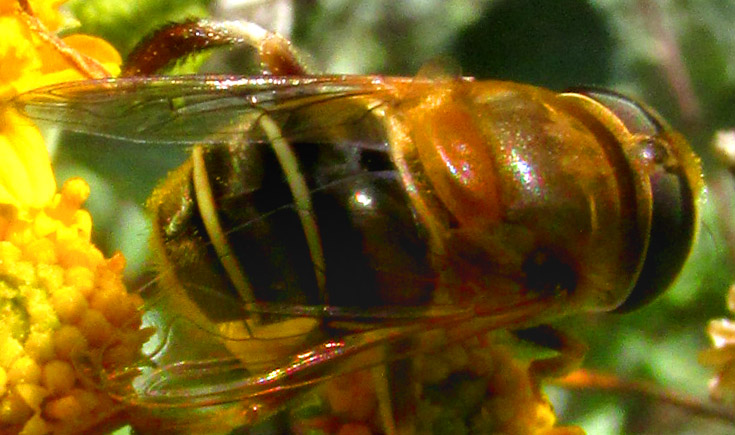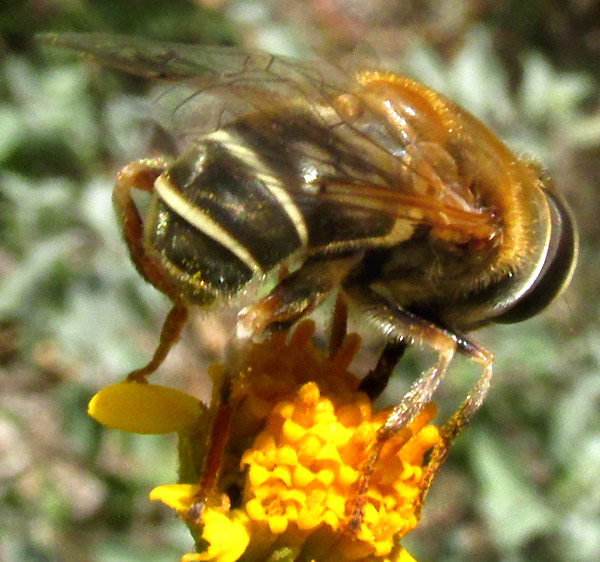Excerpts from Jim Conrad's
Naturalist Newsletter
Entry dated September 26, 2023, issued from near Tequisquiapan; elevation about 1,900m, (6200 ft), ~N20.57°, ~W99.89°; Querétaro state, MÉXICO
GOLDEN PLUSHBACK

When James Hung at Oklahoma University contacted me about a bee I'd written about, he said he'd be glad to see any bee pictures from this part of upland central Mexico. With our two-years-ongoing severe drought and so few flowering plants, it's a bad bee-year. Therefore, when the above was spotted working on some Heliopsis annua flowers, I was glad to get the picture. That golden spot at the back's center seemed unusual.

The above shows the legs, with yellow pollen grains dusting the legs' bottoms.
The problem with the above pictures was that this was not a bee, but rather a fly. Dr. Hung thought it might be PALPADA MEXICANA, "... one of the more common drone flies of Mexico."
Returning to the pictures and looking closely for the first time, it was clear that he was right: The insect bears two wings, like flies of the order Diptera, not four wings like bees, of the order Hymenoptera. In taxonomic terms, confusing a fly for a bee is similar to mistaking a dog for an armadillo, or an oak tree for a locust tree.
Still, you have to admit that the above insect strongly resembles some kind of bee. It's a classic example of Batesian mimicry. That's when a harmless species poses as a harmful one, the idea being that, say, a bird may not count a potential victim's wings, but might see alternating bands on the fly's abdomen, and the golden patch on the back, remember what honeybees look like, and react as if seeing a bee -- exactly as I did.
If I'd had "done the entomology" the way that normally I "do the botany," there would have been no confusion. Not only do flies and bees differ in wing number, but also the antennae are drastically different. In our photos, barely visible projecting beyond the compound eyes at the image's right side, you can see an extremely thin, short antenna, typical of flies. Bee antennae are much more substantial, easily visible, and sharply bent, or "elbowed."
Our Palpada mexicana, sometimes called the Golden Plushback, is distributed from the US southwestern states all through Mexico except for the Yucatan Peninsula, south into northwestern South America. It belongs to the Hoverfly Family, the Syrphidae. Dr. Hung had referred to our fly as a drone fly, reflecting the fact that the Hoverfly Family is divided into four subfamilies, and our fly belongs to the Dronefly Subfamily, the Eristalinae. Our genus Palpada, embracing about 85 species occurring in tje Americas, specializes in colorful and bee-like species. Larvae of its sepcies, sometimes referred to as rat-tailed maggot fly larvae, are aquatic. The rat tail refers to the slender breathing tube larvae use to reach surface air in oxygen-low water. Our area provides little standing water, so it doesn't seem to be a good place for the genus.
Adult Palpada mexicana are "hilltoppers" -- hilltopping being a mating system in which the males take up position on peaktops in spring, and sometimes in the autumn, perching or hovering near certain prominent plants on ridges. The 2011 study by John Alcock entitled "Hilltopping by Palpada mexicana (Diptera: Syrphidae)" found that 20% of males returned on subsequent days to landmarks where earlier they had been captured and marked.
The 1999 study by A. Castañeda-Vildózola and others entitled "Insectos polinizadores del aguacatero en los estados de México y Michoacán, México" listed Palapada mexicana as one of the most important fly species pollinating agricultural fields in Mexico.